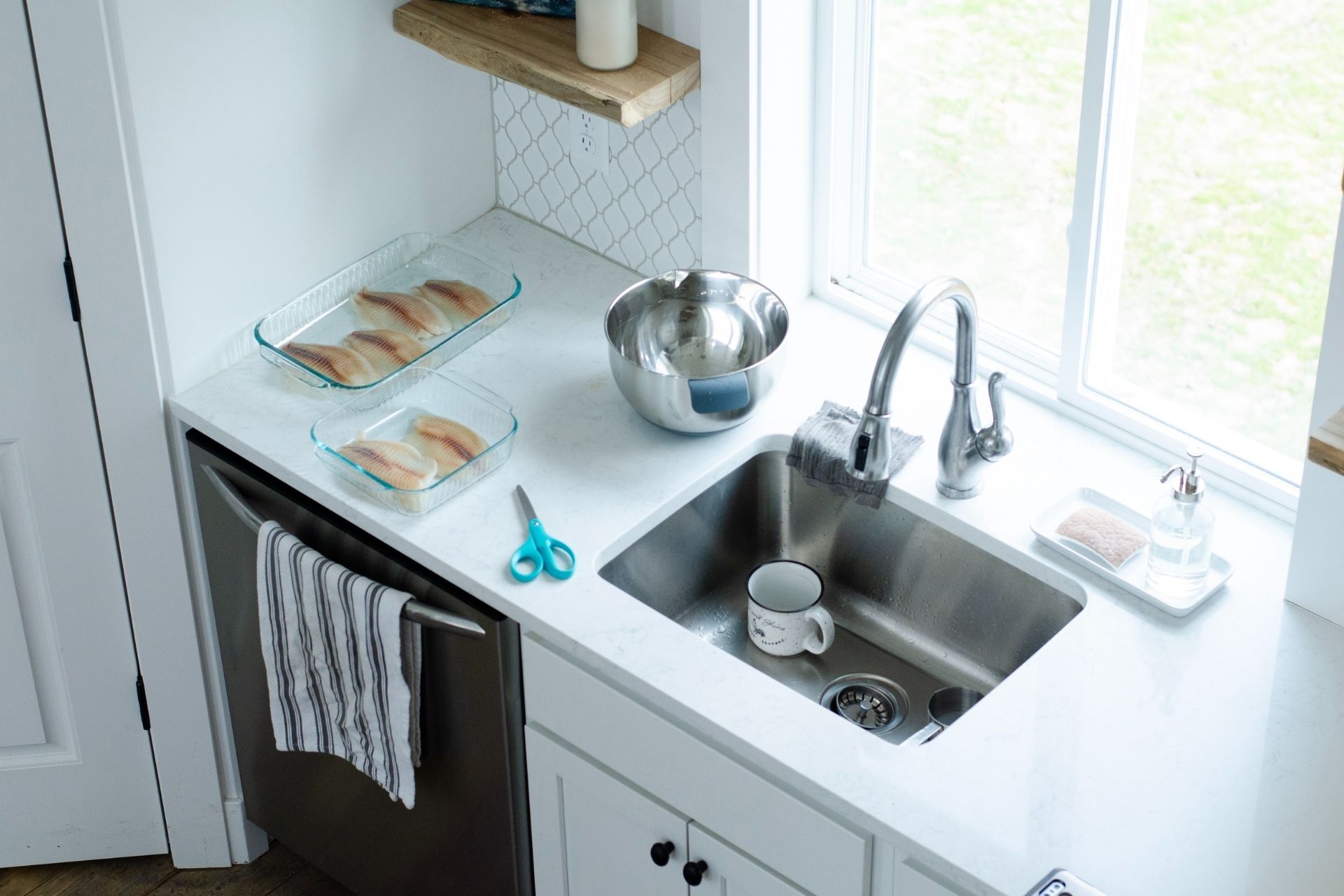
We are reader-supported. When you buy through links on our site, we may earn an affiliate commission.
Garbage disposals have this magical way of making food disappear down the drain. In turn, you save time from throwing away food scraps. Plus, you save the environment from adding more waste to the landfill — food is the largest material disposed of every year.
However, each use comes with its own buildup of food debris. And eventually, it can make the sink smell full of odors.
Meanwhile, garbage disposals are easy to forget they’re there — you might not think about giving them a good once-over clean. Yet like any appliance, you have to know how to clean a garbage disposal since they’re a breeding ground for mold and bacteria.
Why Clean Your Garbage Disposal?
A garbage disposal is a must-have kitchen appliance — especially if you don’t want to risk clogging the pipes each time you wash the dishes.
The food waste sent through your garbage disposal breaks down and miraculously disappears. But as the food gets ground up, small pieces can stick to the splash guard and grinding chamber — eventually decaying.
Additionally, greasy foods and vegetables can build a slimy substance that the disposal can’t reach. After some time, the residue left behind turns into a pool for bacteria. Plus, the more you let it sit, the more difficult it is to clean.
Even though garbage disposals do fairly well at cleaning themselves, the parts that don’t get scrubbed clean can leave an overpowering smell. To prevent food buildup from occurring in the first place, make sure you give it a weekly cleaning.
Supplies You’ll Need
Cleaning the garbage disposal is simple. To give it a proper scrub down, these are the equipment and tools you’ll need:
- Rubber Gloves
- Sink stopper
- Dish soap
- Toothbrush or kitchen sponge with an abrasive side
- ½ cup of baking soda
- ½ to one cup of vinegar
- Ice cubes
- One cup of table salt
- ⅓ cup of bleach
- Citrus peels
How to Clean Your Garbage Disposal
1. Cut the Power
Before you start cleaning your garbage disposal, the most crucial first step is disconnecting its power. Doing so will prevent any harmful accidents and keep you safe.
To cut the power, you can pull the plug connected to the outlet underneath the sink. If you can’t find the outlet, you can always turn off the power by flipping the switch on the breaker box.
Remember, you always want to double-check the power is off. Ensure you test it by turning on the garbage disposal before cleaning.
2. Scrub the Splash Guard
The rubber splash guard or baffle is the most prevalent part of starting the cleaning process. Because it’s full of grooves and crevices, chances are it has trapped food particles and grease underneath it.
Consider pulling it out of the drain to give it a thorough cleaning. You can either use an old toothbrush or an abrasive sponge to scrub off the gunk. Moreover, you can never use too much dish soap. Ensure you grab your toothbrush and start scrubbing vigorously with soap and hot water.
If you’d prefer not to touch the grime with your bare hands, consider putting on rubber gloves. While scrubbing, pay close attention to the underside — this is where most of the debris and slime sit.
3. Remove Leftover Food Debris
While you have the splash guard removed, check for any leftover food particles around the grinder. You can use a flashlight to ensure you can see inside the garbage disposal effortlessly.
If you see food stuck inside your disposal, reach down into it and remove them using tongs or pliers. One thing you want to avoid doing is using your fingers to remove the food. Even though the garbage disposal is off, they have impellers that could nick you.
So for safety reasons, ensure you follow the manufacturer’s advice.
4. Pour in Baking Soda, Vinegar and Bleach
Using half a cup of baking soda, pour it into the garbage disposal. Let the baking soda sit for at least half an hour. That way, it can get rid of the smell inside it.
After letting it sit, pour in a cup of vinegar. Doing so will cause the foam to bubble up into the sink. Baking soda and vinegar are powerful agents that can eliminate all the scum in your disposal. Just be sure to let it remain for a few minutes before rinsing it out with hot water or a pot of boiling water.
Additionally, you can use ⅓ cup of bleach to kill any remaining bacteria. But the vinegar and baking soda should do a good enough job all on their own.
5. Grind Salt and Ice
You can clean the grinder and loosen any buildup with salt and ice. First, you’ll have to reinstall the splash guard and power on the garbage disposal by reconnecting it. Next, you can pour in one to two cups of ice. Then add a cup of salt.
After filling your disposal with salt and ice, run the cold water and turn it on. Keep running the disposal until the grinding noise of the ice stops.
By using the ice and salt, the two components work together as a scrubbing agent.
6. Grind Citrus Peels
The last step of cleaning your garbage disposal is every homeowner’s favorite part because of the freshness it adds. Save your leftover lemon or orange peels — or any citrus fruit.
Stuff the citrus peels into the garbage disposal and run cold tap water down the drain. Flip the switch to run it and let it grind up the peels. Be careful not to put too many or too few peels as this can clog the drain.
Using citrus is best because it leaves behind a pleasant fruity scent. Plus, it refreshes the entire sink.
The Don’ts of Cleaning Garbage Disposals
Many experts will advise you to avoid using commercial cleaning products for a garbage disposal. Most aren’t powerful enough to clean off the residue. Plus, some cleaners contain corrosive chemicals that damage the metal parts of the appliance.
In addition, you should always avoid pouring lye or a chemical drain cleaner into the garbage disposal for the same reasons.
Tips for General Use and Care
It’s always good to keep the gunk and odors at bay. When using the garbage disposal, be sure to run water before, during and after grinding the food.
Many times, the cause of odors comes from the foods that haven’t fully exited the disposal and drainpipes. Of course, you won’t be able to see it, but you sure can smell it.
So before you turn on the disposal, turn on the cold water. Then wait for five to ten seconds after hearing the grinding noise stop. Keeping the water on allows the food to move thoroughly through the pipes once it leaves the disposal.
Furthermore, you can always give it one more water flush after the disposal is off for good measure. Just be sure not to put grease or fat down the disposal. According to experts, 70% of sewage overflows are relevant to grease, and 33% of people have put it down in their disposals.
Grease or starchy foods — like week-old rice or macaroni — gum up your garbage disposal and clog the drain.
Take Care of Your Garbage Disposal
Like all appliances, you have to know how to care for your garbage disposal to ensure it lasts longer. While disposals don’t require much maintenance, they need weekly cleaning with the right cleaning products. Now that you know how to clean a garbage disposal, keep utilizing these tips for proper care.










